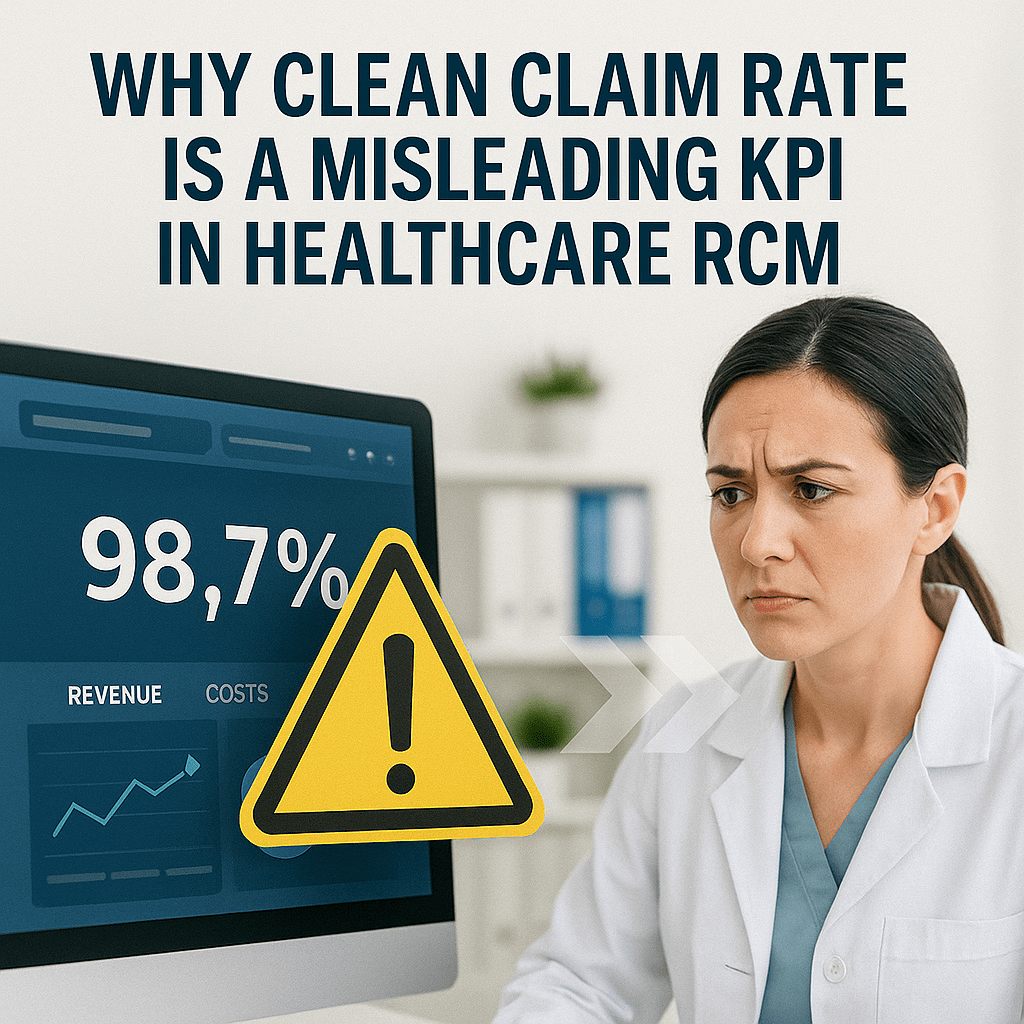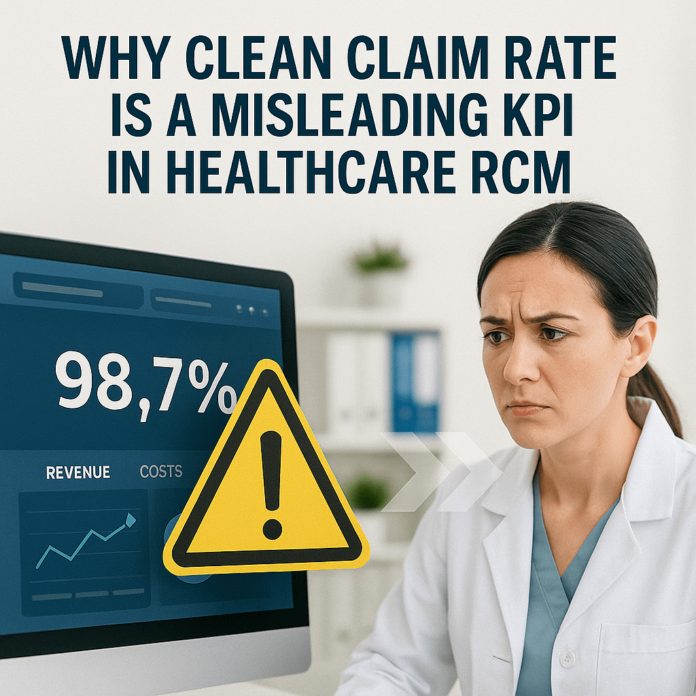Introduction — The Shiny Number That Hides Bad News
Ask any revenue-cycle manager how their billing shop is doing and you’ll likely hear one figure first: clean-claim rate (CCR). On paper, a 98 % CCR sounds bullet-proof—payers accepted almost every claim! Yet executives still complain about high days in A/R, write-offs creep north of 3 %, and collection costs keep climbing. How can both realities be true? Because CCR measures the wrong moment in the claim life cycle. It tells you only that a clearinghouse or payer’s front-end edits didn’t kick the claim back today. It says nothing about whether the claim will be paid in full, on time, and at the contracted rate. This article unpacks the flaws baked into clean-claim rate, then walks through seven alternative KPIs that reveal the revenue truth your CFO actually cares about.
1 Definition Refresher: What Counts as a “Clean” Claim?
Most systems define a clean claim as one that:
- Passes all practice-management (PM) edits.
- Clears the clearinghouse without rejection.
- Is accepted into the payer’s adjudication engine.

Notice what’s missing: payment. A claim can sail through these gates and still be denied down the road, partially paid, or under-paid. Worse, different clearinghouses and payers apply wildly different edit sets, so a 99 % clean-claim rate at Blue Cross may equal a 90 % at UnitedHealthcare. The metric is neither standardized nor cash-linked.
2 How Clean-Claim Rate Becomes a Vanity Metric
2.1 Resubmission Loops
Billing teams often resubmit rejected claims until they pass. Each attempt that finally clears boosts the clean-claim rate numerator—even if the first three tries clogged staffing and slowed cash.
2.2 Exclusion Games
Some PM platforms calculate clean-claim rate only on primary claims. Clean secondary, tertiary, workers’-comp, or corrected claims often get thrown out of the equation, artificially inflating the rate.
2.3 “Accept, Then Deny” Payers
Many national payers accept claims into adjudication (counted as “clean”) and then issue denials days later once medical-necessity or coordination-of-benefits rules run. Clean-claim rate never sees the reversal.
The net effect: a shop can boast a 97 % clean-claim rate and still watch 15 % of gross charges linger beyond 90 days, bleeding cash and staff hours.
3 What Matters More Than Initial Acceptance
Revenue-cycle health depends on three Cs: Cash, Cost, and Compliance.
- Cash: How fast and how completely do dollars arrive?
- Cost: How many staff touches—or outsourced fees—does each dollar require?
- Compliance: Are you avoiding take-backs, refunds, and audit penalties?
CCR answers none of these. So let’s swap it for a metric mix that does.
4 Seven KPI Upgrades That Beat Clean-Claim Rate
4.1 First-Pass Yield (FPY)
Definition: Percentage of total allowed reimbursement paid in full on the very first payer response.
Why it’s better: Captures both claim acceptance and payment completeness. A $1 000 claim paid at $900 due to modifier error drags FPY down, even though clean-claim rate said “clean.”
4.2 Net Denial Rate (NDR) by Dollar Value
Definition: Denied dollars ÷ total gross charges.
Why it’s better: Denials are weighted by financial impact, not claim count, spotlighting high-dollar problem codes or plans.
4.3 Touchless Claim Percentage
Definition: Share of claims that travel from charge entry to paid without a single human redo, appeal, or phone call.
Why it’s better: Marries cash velocity to labor cost, the perfect metric for automation ROI.
4.4 Days in Accounts Receivable (DAR) Stratified
Split DAR into 0-30, 31-60, 61-90, 91-120, and 120+ buckets by payer and location. A climbing 31-60 segment flags payer backlogs faster than blended DAR.
4.5 Cash as Percent of Net Charges (CPNC)
Definition: Payments for the month ÷ net charges for the month.
Why it’s better: Neutralizes seasonality (flu spikes, elective surgery dips) and paints a truer month-over-month cash picture.
4.6 Appeal Success Rate
Definition: Dollars overturned on appeal ÷ dollars appealed.
Why it’s better: Exposes whether denial-management workflows are paying off or just recycling work.
4.7 Cost to Collect
Definition: Total billing expense (labor + vendor + tech) ÷ total collections.
Why it’s better: Puts a dollar sign on every extra claim touch. A high clean-claim rate team that spends $0.12 per dollar to collect is still leaking margin.
5 Building a Balanced RCM Scorecard
Relying on a single KPI—clean or not—creates tunnel vision. Instead, build a monthly scorecard:
| Metric | Target | Why It Matters |
|---|---|---|
| First-Pass Yield | ≥ 90 % | Predicts cash velocity |
| Net Denial Rate | ≤ 5 % | Captures dollar impact |
| Touchless % | ≥ 70 % | Measures efficiency |
| DAR (total) | < 38 days | Industry benchmark |
| 91-120 DAR | < 8 % of A/R | Flags aged risk |
| CPNC | ≥ 95 % | Healthy cash ratio |
| Cost to Collect | ≤ 8 % | Margin guardrail |
Review variances monthly, drill into payers and service lines, and feed findings back to registration, coding, and clinical ops.
6 Data Governance: Getting the Numbers Right
A metric is only as credible as its data pipeline. Steps:
- Source of Truth: Lock each metric to a single system—avoid Excel recalc nightmares.
- Standardize Definitions: Publish what counts as a denial, touch, or appeal.
- Automate Refresh: Nightly ETL jobs push clean tables to a BI dashboard; no manual merges.
- Audit Trails: Keep snapshots so Finance can reconcile with GL cash.
- Stakeholder Training: Ops leaders must know how each KPI ties to their workflow.
7 Case Snapshot—Orthopedic Group Fixes the “Great Clean-Claim Rate Illusion”
A 12-provider ortho practice flaunted a 98.5 % clean-claim rate but still carried $2.1 M in A/R > 90 days. Switching to FPY exposed that only 82 % of dollars were paid first-pass; the rest cycled through refunds, partial pays, or medical-necessity denials.
Interventions:
- Turned on real-time eligibility for DME claims.
- Auto-added surgical modifiers via EHR rules.
- Launched a payer-specific denial bot that submits appeals within 48 hours.
Results after 6 months:
| KPI | Before | After |
|---|---|---|
| First-Pass Yield | 82 % | 93 % |
| Net Denial Rate | 6.8 % | 3.4 % |
| Touchless % | 54 % | 78 % |
| DAR | 46 days | 32 days |
| Cost to Collect | 11.2 % | 7.9 % |
The practice slashed aged A/R by $1 M and recovered $120 K in denied joint-replacement claims—all without obsessing over clean-claim rate.
8 Action Plan—Replace Clean-Claim Rate in 30 Days
- Week 1: Define new KPIs, align on formulas, and pull baseline numbers.
- Week 2: Build or tweak BI dashboards to display FPY, NDR, Touchless %.
- Week 3: Train registration, coding, and billing teams—show them how their work hits each metric.
- Week 4: Launch weekly huddles to review outliers; feed insights into payer-specific worklists.
Within one billing cycle, leaders will talk in terms of dollars recovered and cost saved, not just “How clean were the claims?”
Conclusion — Turn Off the Clean-Claim Rate Spotlight and Light Up the Whole Stage
Clean-claim rate earned its popularity because it’s easy to generate and easy to brag about. But ease breeds complacency. In 2025’s tightening reimbursement climate, revenue-cycle teams can’t afford vanity metrics. Swapping clean-claim rate for a balanced scorecard—anchored by First-Pass Yield, Net Denial Rate, Touchless Claims, and Cost to Collect—shifts the conversation from claims sent to cash secured. That’s the language the C-suite understands, and the language search engines reward when providers look for practical RCM advice.




